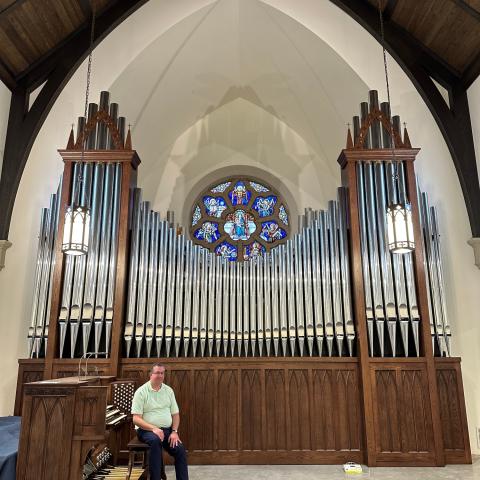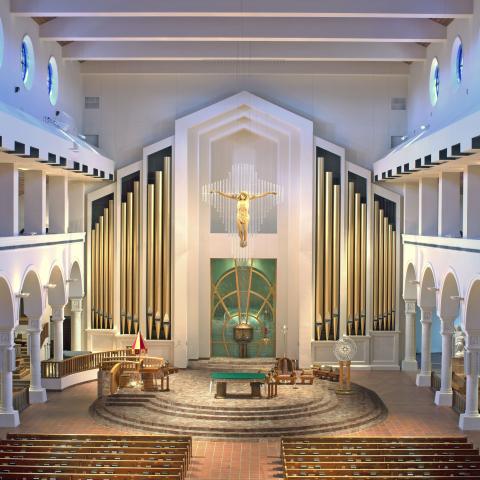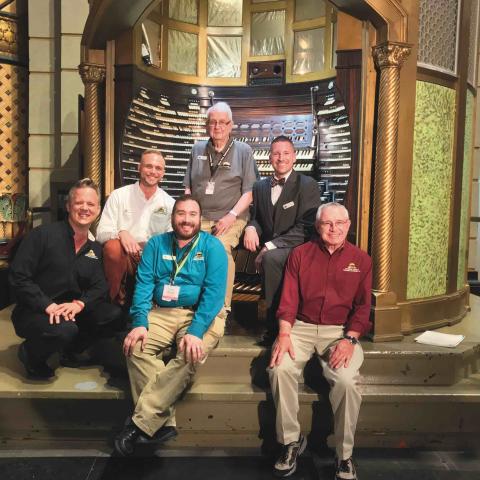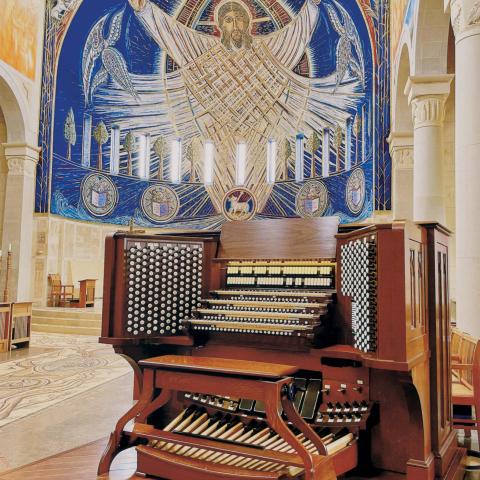Kegg Pipe Organ Builders, Hartville,
Ohio, 30th anniversary

Kegg Pipe Organ Builders began building new pipe organs in 1990, and 2020 marks thirty years with project opera 64, 65, and 66 presently under construction. Opus 64 is a new 47-rank four-manual instrument for Christ the King Chapel at Christendom College in Front Royal, Virginia. Opus 65 is a new console and restoration of the California Organ Company/Reuter organ in the St. Francis Auditorium at the Museum of New Mexico in Santa Fe. Opus 66 is a new organ for Little Flower Church in St. Louis, Missouri.
I discovered the pipe organ at age eleven and by age thirteen, I had a playing pipe organ of nine ranks in my basement. I had very tolerant parents. After graduating high school, I began working at the Schantz Organ Company in the console department. After a year there, I went back to school to study architecture and mechanical engineering, after which I returned to the Schantz company to train as a reed voicer. I spent five years with Schantz as a production reed voicer and tonal finisher. I then joined Casavant Frères, Limitée where I was a sales representative. I also installed and voiced a number of Casavant organs during my five years with them. I then went to A. R. Schopp’s Sons, a fourth-generation pipe making company and a leader in the United States pipe organ supply industry, where I was general manager. After an enjoyable time there and with three different churches asking me to do work for them, which I took as a sign, I left my friends at Schopp to found Kegg Pipe Organ Builders.
Wanting to start small and build the business carefully, I began in a 1,500-square-foot shop and built my first three instruments by myself, gradually adding employees as business demand grew. In 1994, the company moved into a 5,000-square-foot building with three employees where we built many instruments including the landmark 78-rank instrument for the Basilica of St. John the Baptist in Canton, Ohio. After ten years in that location, the company with five employees received a commission to build another landmark 70-rank instrument for the new concert hall at Texas A&M International University in Laredo, Texas. This instrument demanded a larger space, and in 2004 the company moved into its present shop enjoying 16,000 square feet of space. The company employs eight at this writing, three of whom are under the age of 35.
Early on in my career, I felt that instruments designed and built in a more Romantic style than was popular in the 1970s and ’80s would better suit traditional American church music. It also appealed to me more with my interest in warmer sounds. This was first demonstrated in my third organ built for the First Baptist Church in Canton, Ohio, which was the Kegg family church. This organ, completed in 1990, comprises two manuals and 25 ranks, with the Great under expression, save for the 8′ Principal. In 1990, an enclosed Great was most unusual and considered heretical by many. The organ caused quite a stir in 1990 with its large scales, warm sound, and Swell Vox Humana. A new Vox Humana was, again, highly unusual at that time.
Another point of departure for me was my interest in all-electric chest action. This style of action had long been vilified due to its usual poor construction. All-electric action offers many advantages including ultra simplicity, ease of repair from water damage, and the ability to offer judicious borrowing of stops at different pitches and/or manuals. Its primary disadvantage is the poor pipe speech that is associated with it. I worked at developing chest construction with the goal of making this action indistinguishable from a pneumatic pouch windchest. My successful result has met that goal. While not inexpensive to build, it is reasonable at scale and offers our clients all the advantages with none of the disadvantages. Our instruments only employ pneumatic chests for large basses and high-pressure stops. This reduces or eliminates the leather wear found in pneumatic instruments.
We employ schwimmer air regulator control. These air regulators that are built into the chests regulate pressure more efficiently than standard reservoirs and are easier and less expensive to maintain. While you will find standard reservoirs in our instruments for large pipes and occasional other use, you will find very few in our instruments compared to other engineering traditions. All this is done with the goal of making the Kegg instrument one that is musically responsive, colorful, interesting for the musician and listener, cost effective to purchase, and inexpensive to maintain.
I spent a great deal of time working with the American Organ Institute in Norman, Oklahoma, when it was operating, encouraging young people who were interested in the pipe organ craft, understanding that new generations must be brought into our craft. Two AOI graduates presently work for the Kegg company. We look for those interested in a career in the pipe organ craft and have had several summer interns over the years.
With thirty-plus years in business, our work can be found in homes, concert halls, churches, and synagogues. With a new generation in house, we look forward to the next thirty years of serving our clients.
—Charles Kegg
The Kegg team
Philip Brown
Michael Carden
Cameron Couch
Joyce Harper
Philip Laakso
Bruce Schutrum
Paul Watkins
Website: http://www.keggorgan.com/
Photo: Basilica of Saint John the Baptist, Canton, Ohio (photo courtesy: Kegg Pipe Organ Builders)
Opus 3, First Baptist Church, Canton, Ohio
GREAT
16′ Bourdon TC (Chimney Flute)
8′ Principal 61 pipes
8′ Chimney Flute 61 pipes
8′ Gemshorn 61 pipes
4′ Octave 61 pipes
4′ Flute (ext) 12 pipes
2′ Fifteenth (ext) 12 pipes
1-1⁄3′ Mixture IV 244 pipes
Sesquialtera II TC 98 pipes
8′ Trumpet (Swell)
Tremulant
Chimes (Deagan 25 notes)
SWELL
16′ Bourdon 61 pipes
8′ Bourdon (ext) 12 pipes
8′ Viole 61 pipes
8′ Viole Celeste TC 49 pipes
4′ Principal 61 pipes
4′ Koppelflute 61 pipes
2-2⁄3′ Nazard 61 pipes
2′ Flute (ext) 12 pipes
1-1⁄3′ Larigot (Nazard)
1′ Mixture IV 244 pipes
16′ Contra Trumpet 61 pipes
8′ Trumpet (ext) 12 pipes
8′ Oboe 61 pipes
8′ Vox Humana 61 pipes
Tremulant
PEDAL
16′ Principal 32 pipes
16′ Subbass 32 pipes
16′ Bourdon (Swell)
8′ Principal (ext) 12 pipes
8′ Subbass (ext) 12 pipes
4′ Octave (ext) 12 pipes
32′ Harmonics (derived)
16′ Trumpet (Swell)
4′ Oboe (Swell)
Full complement of couplers
Opus 28, Basilica of St. John the Baptist, Canton, Ohio
GREAT
16′ Violone 61 pipes
8′ Principal 61 pipes
8′ Hohlflute 49 pipes (bass from Pd 16′ Bourdon)
8′ Bourdon (Pd 16′ Bourdon) 17 pipes
8′ Violoncello (ext) 12 pipes
8′ Gemshorn 61 pipes
5-1⁄3′ Rohrquinte 61 pipes
4′ Octave 61 pipes
4′ Koppelflute 61 pipes
2-2⁄3′ Twelfth 61 pipes
2′ Fifteenth 61 pipes
IV Fourniture 244 pipes
16′ Contra Trumpet 61 pipes
8′ Trumpet (ext) 12 pipes
8′ French Horn (Solo)
4′ Clarion 61 pipes
Tremulant
Chimes (Deagan 25 notes)
Zimbelstern
SWELL
16′ Lieblich Gedeckt 61 pipes
8′ Open Diapason 61 pipes
8′ Gedeckt 61 pipes
8′ Clarabella 61 pipes
8′ Salicional 61 pipes
8′ Voix Celeste 61 pipes
8′ Aeoline 61 pipes
8′ Unda Maris TC 49 pipes
4′ Octave 61 pipes
4′ Flute 61 pipes
2-2⁄3′ Nazard 61 pipes
2′ Flautino 61 pipes
1-3⁄5′ Tierce 61 pipes
IV Plein Jeu 244 pipes
IV Scharf (PJ 8va)
16′ Double Trumpet 61 pipes
16′ Oboe TC (Oboe)
8′ Trumpet (ext) 12 pipes
8′ Oboe 61 pipes
8′ Vox Humana 61 pipes
4′ Clarion 61 pipes
Tremulant
CHOIR
8′ Open Diapason 61 pipes
8′ Stopped Flute 61 pipes
8′ Spitzflute 61 pipes
8′ Flute Celeste TC 49 pipes
8′ Dolce 61 pipes
8′ Dolce Celeste TC 49 pipes
4′ Octave 61 pipes
4′ Flute 61 pipes
2′ Piccolo 61 pipes
1-1⁄3′ Larigot 61 pipes
1′ Sifflute 61 pipes
8′ Cornopean 61 pipes
8′ Clarinet 61 pipes
Tremulant
8′ Tuba Mirabilis (Solo)
SOLO
8′ Doppelflute 61 pipes
8′ Gross Gamba 61 pipes
8′ Gross Gamba Celeste 61 pipes
4′ Hohlpfeife 61 pipes
8′ Orchestral Oboe 61 pipes
8′ English Horn 61 pipes
Tremulant
16′ Contra Trumpet TC (Great)
8′ Neumann Trumpet 61 pipes
8′ Tuba Mirabilis 61 pipes (high pressure)
8′ French Horn
8′ Blair Trumpet II (draws Tuba and Antiphonal Trumpet Magna)
8′ Trumpet (Great)
8′ Cornopean (Choir)
8′ Oboe (Swell)
8′ Clarinet (Choir)
4′ Clarion (Great)
Chimes (Great)
String FF Ensemble (collective)
String PP Ensemble (collective)
Unison Ensemble (collective)
Reed Ensemble (collective)
ANTIPHONAL (Floating)
8′ Gedeckt 61 pipes
8′ Salicional 61 pipes
8′ Voix Celeste TC 49 pipes
8′ Flute Celeste II 110 pipes
8′ Unda Maris II 98 pipes (bass from Flute Celeste)
4′ Fugara 61 pipes
4′ Flute (ext) 12 pipes
4′ Unda Maris II (ext) 24 pipes
8′ Vox Humana 61 pipes
8′ Trumpet Magna 61 pipes
Tremulant
PEDAL
32′ Resultant (derived)
32′ Bourdon (1–12 electronic)
32′ Lieblich Gedeckt (1–12 electronic)
16′ Open Diapason (wood) 32 pipes
16′ Bourdon 32 pipes
16′ Violone (Great)
16′ Lieblich Gedeckt (Swell)
16′ Dulciana 32 pipes
8′ Octave (ext) 12 pipes
8′ Diapason (Swell)
8′ Diapason (Choir)
8′ Violoncello (Great)
8′ Bourdon (ext) 12 pipes
8′ Dulciana (ext) 12 pipes
4′ Super Octave (ext) 12 pipes
4′ Still Flute (ext) 12 pipes
32′ Contra Trombone 32 pipes
32′ Harmonics (derived)
16′ Trombone (ext) 12 pipes
16′ Trumpet (Swell)
8′ Tromba (ext) 12 pipes
4′ Clarion (ext) 12 pipes
4′ Clarinet (Choir)
4′ Oboe (Swell)
Full complement of couplers
Opus 64, Christendom College, Front Royal, Virginia
GREAT
16′ Violone 61 pipes
8′ Solo Diapason IV (from Gt Prin, Gt Octave, Pd Prin, Pd C. Bass)
8′ Principal 61 pipes
8′ Violone (ext) 12 pipes
8′ Rohrflute 61 pipes
8′ Harmonic Flute 49 pipes (1–12 from Rohrflute)
4′ Octave 61 pipes
4′ Flute (ext) 12 pipes
2-2⁄3′ Twelfth 61 pipes
2′ Fifteenth 61 pipes
1-1⁄3′ Mixture IV 244 pipes
16′ Tromba 61 pipes
8′ Tuba (Choir)
8′ Tromba (ext) 12 pipes
4′ Tromba Clarion 61 pipes
Tremulant
SWELL
16′ Gedeckt 61 pipes
8′ Diapason 61 pipes
8′ Gedeckt (ext) 12 pipes
8′ Salicional 61 pipes
8′ Voix Celeste 61 pipes
4′ Octave 61 pipes
4′ Salicet (ext) 12 pipes
4′ Spitzflute 61 pipes
2-2⁄3′ Nazard 61 pipes
2′ Flute 61 pipes
1-3⁄5′ Tierce 61 pipes
2′ Mixture IV 244 pipes
16′ Bassoon 61 pipes
8′ French Trumpet 61 pipes
8′ Oboe (ext) 12 pipes
8′ Vox Humana 61 pipes
4′ Clarion (ext) 12 pipes
Tremulant
CHOIR
8′ Geigen Diapason 61 pipes
8′ Voce Humana 61 pipes
8′ Melodia 61 pipes
8′ Flauto Dolce 61 pipes
8′ Flute Celeste TC 49 pipes
4′ Octave 61 pipes
4′ Open Flute 61 pipes
2′ Fifteenth (ext) 12 pipes
8′ Tuba (high pressure) 61 pipes
8′ Clarinet 61 pipes
Tremulant
Chimes
SOLO
8′ Solo Diapason IV (from Gt Prin, Gt Octave, Pd Prin, Pd C. Bass)
8′ Flauto Dolce (Choir)
8′ Flute Celeste (Choir)
8′ Doppelflute 61 pipes
8′ English Horn 61 pipes
Tremulant
8′ Tuba Magna (high pressure) 61 pipes
8′ Tuba (Choir)
8′ French Horn 61 pipes
PEDAL
32′ Bourdon 32 pipes
16′ Open Diapason (wood) 32 pipes
16′ Subbass (ext) 12 pipes
16′ Violone (Great)
16′ Gedeckt (Swell)
8′ Principal 32 pipes
8′ Subbass (ext) 12 pipes
8′ Violone (Great)
8′ Gedeckt (Swell)
4′ Choral Bass 32 pipes
2′ Cantus Flute (Gt Harmonic Flute)
32′ Trombone 32 pipes
32′ Harmonics (derived)
16′ Trombone (ext) 12 pipes
16′ Tromba (Great)
16′ Bassoon (Swell)
8′ Trumpet 32 pipes
4′ Clarion (ext) 12 pipes
4′ Clarinet (Choir)
Pedal Divide
Full complement of couplers
Virtuoso control system
Opus 66, Little Flower Catholic Church, St. Louis, Missouri
GREAT
16′ Gemshorn (ext, Choir) 12 pipes
8′ Solo Diapason III (from Gt Prin, Gt Octave, Pd Prin)
8′ Principal 61 pipes
8′ Harmonic Flute (Choir)
8′ Gemshorn (Choir)
4′ Octave 61 pipes
4′ Harmonic Flute (Choir)
2′ Fifteenth (ext) 12 pipes
2′ Mixture IV (cancels 15th) 244 pipes
8′ Tuba 61 pipes (high pressure, separate enclosure)
8′ Trumpet (Swell)
8′ Clarinet (Choir)
Chimes (Deagan, 25 notes)
SWELL
16′ Gedeckt 61 pipes
8′ Geigen Diapason 61 pipes
8′ Gedeckt (ext) 12 pipes
8′ Salicional 61 pipes
8′ Voix Celeste 61 pipes
4′ Principal 61 pipes
4′ Salicet (ext) 12 pipes
4′ Open Flute 61 pipes
2-2⁄3′ Nazard 61 pipes
2′ Octave (ext) 12 pipes
2′ Piccolo (ext) 12 pipes
1-3⁄5′ Tierce TC 37 pipes
1-1⁄3′ Larigot (Nazard)
16′ Trumpet 61 pipes
8′ Trumpet (ext) 12 pipes
8′ Oboe 61 pipes
4′ Clarion (ext) 12 pipes
Tremulant
CHOIR
8′ Gemshorn 61 pipes
8′ Harmonic Flute 61 pipes
8′ Dulciana 61 pipes
8′ Unda Maris TC 49 pipes
4′ Principal 61 pipes
4′ Flute (ext) 12 pipes
2′ Octave (ext) 12 pipes
V Cornet (Swell)
8′ Oboe (Swell)
8′ Tuba (Great)
8′ Clarinet 61 pipes
Tremulant
PEDAL
32′ Resultant (derived)
16′ Open Diapason (wood) 32 pipes
16′ Bourdon 32 pipes
16′ Gemshorn (Choir)
16′ Gedeckt (Swell)
8′ Principal 32 pipes
8′ Bass Flute (ext) 12 pipes
8′ Gemshorn (Choir)
4′ Octave (ext) 12 pipes
4′ Flute (Choir)
32′ Harmonics (derived)
16′ Trumpet (Swell)
8′ Trumpet (Swell)
4′ Clarinet (Choir)
Full complement of couplers







